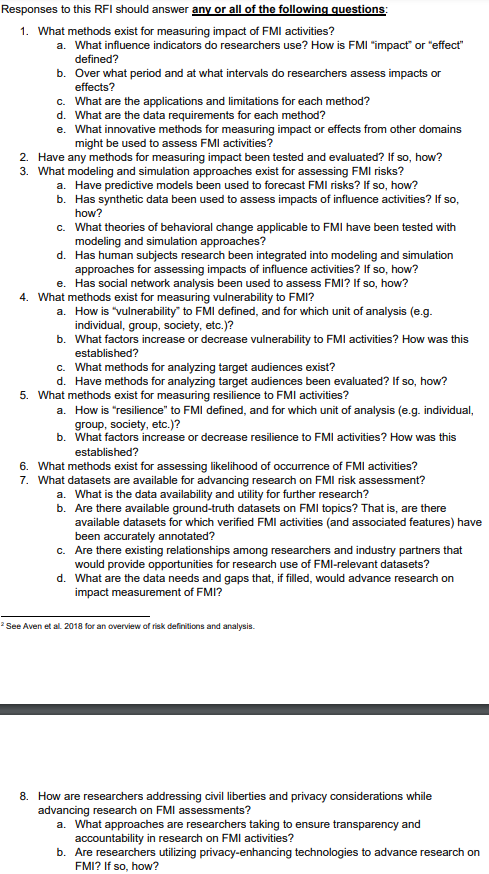The R&D funding arm of the US spy community, IARPA, is looking for “information on methodologies to assess Foreign Malign Influence” while assuring it doesn’t intend to use it on the US population.
While not yet an official research program, the US Intelligence Advanced Research Projects Activity (IARPA) has put out a request for information (RFI) for Methodologies To Assess Foreign Malign Influence (FMI).
“Respondents are encouraged to describe research approaches that involve foreign malign influence activities against foreign (non-US) populations. IARPA does not intend to apply assessment methodologies to the US population”
IARPA, Methodologies To Assess Foreign Malign Influence
According to the RFI:
“FMI includes subversive, undeclared (including covert and clandestine), coercive or criminal activities by foreign governments, non-state actors, or their proxies to affect another nation’s popular or political attitudes, perceptions, or behaviors to advance their interests.
“This can include efforts to sow division, undermine democratic processes and institutions, or steer policy and regulatory decisions in favor of the foreign actor’s strategic objectives.”
“Respondents are encouraged to specify the FMI activities (what, how, where, and against whom) for which assessment methodologies are applicable”
IARPA, Methodologies To Assess Foreign Malign Influence
So, what types of assessment methodologies are the US spy community looking for?
For starters, “IARPA is not interested in research on FMI detection, attribution, or mitigation.”
Instead, they are “interested in characterization of research on methodologies to assess FMI activities and risks.”
“Risk” is then defined as:
A measure of the extent to which an entity is threatened by a potential circumstance
or event, and typically is a function of:
- the adverse impact, or magnitude of harm, that would arise if the circumstance or event occurs
- the likelihood of occurrence
“Has social network analysis been used to assess Foreign Malign Influence? If so, how?”
IARPA, Methodologies To Assess Foreign Malign Influence

Elections are a major target for Foreign Malign Influence campaigns that involve the response of multiple government agencies.
For example, the Office of the Director of National Intelligence (ODNI) has a dedicated Foreign Malign Influence Center (FMIC), which also houses the Election Threats Executive (ETE).
The ETE “serves as the IC’s [Intelligence Community’s] coordinating and integrating authority on all election security activities, initiatives, and programs.
“In this role, FMIC leads the IC’s efforts to identify and assess foreign malign influence and interference in US elections.”
Another government agency involved in assessing and countering FMI is the Cybersecurity and Infrastructure Security Agency (CISA).
“Since at least 2016, we have seen foreign malign influence campaigns specifically promote messaging that undermines public confidence in the security and integrity of the American elections process and exacerbate partisan tensions,” reads one CISA report from April, 2024.
The FBI, too, has its own response to foreign malign influence.
The FBI website states that “In the fall of 2017, Director Christopher Wray established the Foreign Influence Task Force (FITF) to identify and counteract malign foreign influence operations targeting the United States.”
Members of the FBI’s Foreign Influence Task Force “work closely with other US government agencies and international partners concerned about foreign influence efforts aimed at their countries.”
The latest RFI from IARPA says it not interested in FMI detection or mitigation because those tasks have already been assigned within the FMIC, the FITF, and elsewhere.
Going forward, IARPA is looking for better ways to more efficiently assess the activities and risks that have already been identified.
And while IARPA says that it “does not intend to apply assessment methodologies to the US population,” the RFI doesn’t say anything about handing over its findings to intelligence partners in the Five Eyes network, which could potentially apply the methodologies to US citizens.
Last year, the Economic Times reported the the Five Eyes network, which consists of the intelligence agencies of the United States, the United Kingdom, Canada, Australia, and New Zealand, “has been accused of wrong-doings, mainly for spying on citizens of each other to evade responsibilities imposed by the local law.”
At the end of the day, the latest IARPA RFI is looking for research methodologies “that involve foreign malign influence activities against foreign (non-US) populations.”












